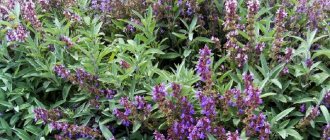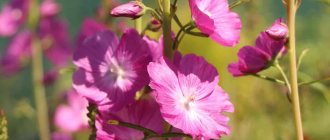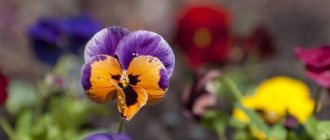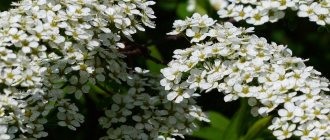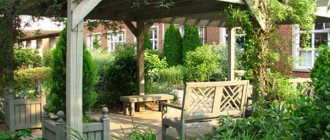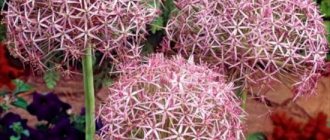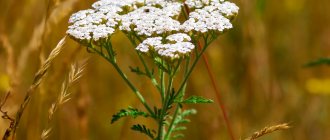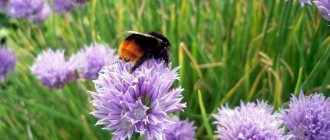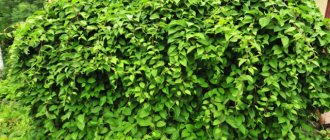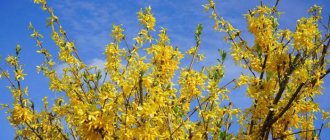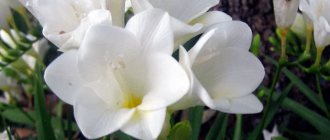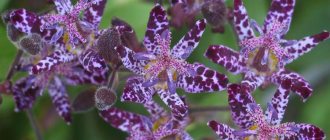Bee sage
Pigeon sage (S. columbariae)
An annual plant from the southwestern regions of North America.
Like Spanish sage (S. hispanica), widely cultivated by the Aztecs as a staple food before the Spanish colonized the Americas, this plant produces tiny seeds very rich in omega-3 fatty acids, antioxidants, vitamins, minerals and fiber. Related article:
How is aloe "Stoletnik" different from aloe vera?
Sage pigeon
Diviner's sage (S. divinorum)
The variety exists only in culture and was used for many centuries by Mexican Mazatec shamans as a means of inducing prophetic visions and promoting spiritual cleansing. Despite the hype surrounding it, this plant has nothing in common with either LSD or cocaine.
Sage Diviners
According to doctors, it does not cause pathological dependence and does not have toxic properties. But in Australia, South Korea, Belgium, Italy and Denmark, this “weed” is prohibited.
Species with fragrant foliage. Some of these plants are used in cooking. Pineapple sage, which has narrow clusters of red flowers and pineapple-scented leaves, is often used to flavor drinks and as a seasoning for desserts.
Related article:
Orchis spotted - a medicinal plant in a summer cottage
One variety of this sage (Honey Melon) smells like cantaloupe, while Doris sage (S. dorisiana), with its large, lush clusters of pink flowers and wide leaves, smells of peach and other fruits. Cleveland sage (S. clevelandii), which grows in California, also has very fragrant leaves.
Apple sage (S. pomifera) is found on several Greek islands. Local residents candy the translucent galls that form on its leaves and eat them as a sweet.
Salvia guarani
Guarani sage (Salvia guaranitica, syn. S. concolor) is a perennial, one of the most beautiful blue sages.
Its popularity is growing rapidly today. Sage guarana. Photo from indonesiatravelmagazine.com He comes from Brazil, Uruguay, Argentina. Up to 1.5 m high and 60 cm wide. In the south it is not so tall: only 50-60 cm. In foreign lands, the leaves do not reach its characteristic 13 cm, but they are just as textured, wrinkled, with an anise aroma (with rubbing). The flowers are blue, with almost black calyxes, up to 5 cm long; bloom in August.
On the southern coast of Crimea they are trying to grow it in open ground with winter shelter. In English reference literature, its winter temperature minimum is at 0ºС. Therefore, in central Russia it is worth growing in wide containers and garden vases or as an annual (through seedlings). Sowing of seeds is superficial, after stratification for 2-3 months; at a temperature of +18…+24ºС, seedlings appear within 1-3 months. Decorative varieties:
- 'Black and Blue' – up to 2.5 m high, 90 cm wide; flowers are blue, with dark purple cups;
Salvia guarani 'Black and Blue'. Photo from lowcnursery.com
- 'Blue Enigma' – 90 cm wide, fragrant, blue flowers with a bright green calyx;
Salvia guarani 'Blue Enigma'. Photo from ashwoodnurseries.com
- 'Purple Splendour' – 90 cm wide, pubescent leaves, purple flowers.
Use in the countryside Sage guarani is a luxurious beauty that creates a cool color scheme in flower beds.
Salvia guarani in the foreground. Photo from pinterest.co.uk. Sage guarani in the background Photo from definingyourhome.blogspot.com
It will not get lost anywhere: blue flowers will always attract attention with their exotic shape.
Planting sage in open ground
Sage requires careful attention, and its planting must be done responsibly.
Lighting requirements
First of all, you need to choose the right site. The success of cultivation depends on this. Sage is a southern plant and requires a lot of heat and light to develop. And although the lack of sunlight does not lead to the death of the plant, it will grow slowly and bloom extremely reluctantly (if at all).
Soil requirements
for sage , but it will not grow on heavy and clay soils. However, if the soil on the site is clayey, it can be processed and made suitable for planting this crop. To do this, you need to add a mixture of river sand and humus in the fall and dig up the bed well. This preparation will allow the soil to better allow air to pass through.
The main rule when using humus is to know when to stop. Excess fertilizer will negatively affect plant development. When planted on soils with high fertility, the stems grow and flowering fades.
Reference! Excellent precursors for sage would be: potatoes, wheat, legumes, cabbage or onions.
Preparing the soil for planting
The soil at the planting must be carefully dug up and loosened. In order for the plant to feel comfortable, the soil must be well permeable and not retain moisture, so preference should be given to calcareous soils.
Planting sage with seeds
When growing sage from seeds, you must follow the following rules:
- the furrows should be 4 cm deep, the distance between them should be about 20 cm;
- the seeds are laid out 25-30 cm from each other, sprinkled with a very thin layer of earth;
- the first shoots are expected 1.5 - 3 weeks after sowing;
- After their appearance, it is necessary to maintain constant soil moisture for several weeks.
Watch the video! Growing sage
Oak sage
Oak sage (Salvia nemorosa) is an erect, slightly branched perennial up to 1 m high and 60 cm wide. In nature, it grows in the European part of Russia to Central Asia.
Oak sage, photo by the author Leaves are oval to lanceolate, up to 10 cm long; flowers are violet, purple, white, pink, 1 cm long, collected in apical racemes; bloom from summer to autumn.
Decorative varieties:
- 'Ostfriesland' – 45 cm high, dark blue-violet flowers;
Oak sage 'Ostfriesland'. Photo from the website green-garden-orenburg.rf
- 'Lubecca' – dwarf, 45 cm high and wide, gray-green leaves, purple flowers;
Oak sage 'Lubecca'. Photo from lambley.com.au
- This is a whole series of varieties: 'New Dimension Blue', 'New Dimension Rose', 'New Dimension Pink' - flowers of blue, light pink and dark pink colors;
Salvia 'New Dimension Blue'. Photo from jardinjasmin.com
- 'Schneehugel' – white flowers;
Salvia oak grove 'Schneehugel'. Photo from opvallendeplanten.nl
- 'Viola Klose' – bright blue flowers.
Sage 'Viola Klose'.
Photo from the website baumschule-horstmann.de Use in the countryside Oak sages are increasingly captivating the hearts of summer residents, settling in plots for many years.
White sage is among its peers. Photo from pinterest.com
They are incomparable in a wide variety of flower arrangements, into which they introduce harmonious contrasts or complement the flower garden with nuanced combinations.
Salvia sparkling: photo of flowers Salvia splendens
The most famous of the garden species of salvia is a native of Brazil, which has been used in culture for almost 200 years. At home, bushes or herbaceous plants with rigid, erect, tetrahedral stems can reach 20–80 cm in height and bloom en masse throughout the summer and autumn.
Before the start of active breeding work, the clusters of Salvia lucidum, photos of the flowers of which today amaze with the richness of colors and splendor of inflorescences, were not so spectacular. Gardeners had at their disposal only varieties with red corollas and calyxes, loosely sitting on the peduncle.
Today, in addition to red flowers, you can increasingly find salvia shiny white, violet-lilac, and even two-colored.
Sage sticky
The homeland of sticky sage (Salvia glutinosa) is considered to be Central and Southern Europe and Western Asia.
Some of you may have seen this yellow sage in nature, in a shady forest. Sage is sticky, appearance. Photo from davisla.wordpress.com. His flowers. Photo from the site uniprot.org This is an excellent candidate for the flower gardens of lovers of large sages (it is up to 90 cm high and wide), prefers semi-shaded, moist places with fertile, loose soil. Find a secluded place for it on your property near the fence, and your friends will certainly be surprised by its flowering, because sages with yellow flowers are still rare guests at our dachas.
Contraindications
Thoughtlessly using sage for treatment is unacceptable and even dangerous. The use of this plant in some people can only cause complications. You cannot treat with sage in herbal form under the following conditions.
- During pregnancy and breastfeeding;
- Acute forms of lung and kidney diseases;
- Epilepsy.
Preparations containing sage are contraindicated for the following persons.
- With disorders of the thyroid gland;
- Individual intolerance.
Decoctions are not recommended due to natural phytohormones.
- Cancer patients;
- Suffering from endometriosis;
- Patients with uterine fibroids;
- Women with polycystic disease.
It is also prohibited to use the plant for more than three months, since long-term treatment can lead to irritation of the oral mucosa and gastrointestinal tract
Sage lavender
Lavender sage or Spanish sage (Salvia lavandulifolia, syn. S. hispanica) comes from Spain.
It might seem that it would be difficult for lavender to find a double, but it’s not: look at another perennial sage - from a distance you won’t be able to tell it apart from lavender! Sage lavender leaf, appearance. Photo from the site praskac.at Its inflorescences. Photo from mountvenusnursery.com It is frost-hardy. In English reference literature it is given a standard winter minimum of -15ºC; in domestic sources – up to -23ºС. This means that you can try to grow it in open ground in central Russia (the first years after planting you will need shelter for the winter period).
Sage: types and varieties
The huge sage family unites so many decorative species that it is quite possible to create a variety of decorative herbaceous carpet options even for experienced gardeners. An amazing plant - sage. The types and differences between them allow you to choose a plant in accordance with your preferences: some are distinguished by bright flowering, others create a durable and also fragrant carpet, and others have a delicious taste.
Fast-growing, unpretentious and low-maintenance, sage is an excellent partner for many decorative foliage and flowering plants. Most types of sage, photos of which can be found not only in manuals for herbalists, but also on landscape design, have healing properties to one degree or another.
Infusions and decoctions of sage are used to treat infertility, colds and viral diseases. In addition, medicinal preparations based on this plant are effective for a number of skin diseases, endocrine and neurological problems.
Salvia officinalis
It has already settled in the cottages of many users of our site, who especially liked the varieties 'Icterina', 'Tricolor', 'Aurea', 'Kew Gold' - I talked about them on the site in articles:
- If there is sage growing in the garden
- Variegated herbs, vegetables, grains for creative gardens
Salvia officinalis 'Icterina', photo by the author But we somehow completely forgot about the red-leaved sage (Salvia officinalis 'Purpurascens').
Salvia officinalis 'Purpurascens'. Photo from vivaipriola.com. It's in the composition. Photo from garden-shopping.de
It seems like it was specially created for contrasting compositions. Young leaves are especially bright purple in color.
What to remember
- The medicinal properties and contraindications of sage lie in its rich chemical composition. The plant contains essential and fatty oils, tannins, flavonoids, alkaloids, and organic acids.
- Herbal remedies have anti-inflammatory, disinfectant, astringent, diuretic and hemostatic effects.
- Prolonged and uncontrolled use of sage-based products provokes symptoms of poisoning. Therefore, before taking sage for medicinal purposes, you must consult a doctor to prescribe the appropriate dosage and course of administration.
Source
Other useful and medicinal plants
Composition of the blackhead plant, medicinal properties and contraindications
How to use kupena, medicinal properties and contraindications
Medicinal properties and contraindications of chastukha, composition and how to use
Useful properties and contraindications of honeysuckle
Forest sage
Forest sage (Salvia x sylvestris) is a hybrid of w.
Dubravnogo and sh. meadow (S. nemorosa x S. pratensis) with pinkish-violet flowers. Forest sage. Photo from monrovia.com It is light-loving and drought-tolerant. Very winter-hardy: tolerates down to -29ºС, therefore suitable for growing in central Russia.
Decorative varieties:
- 'Blauhugel' – 70 cm high, 45 cm wide, blue-violet flowers;
- 'Rose Queen' – 75 cm high, deep pink flowers;
Salvia 'Blauhugel'. Photo from pga.com.au. Salvia 'Rose Queen'. Photo from whiteflowerfarm.com
- 'Blue Hill' – dark blue flowers;
- 'May Night' – height 70 cm, width 40 cm; flowers light purple and others.
Forest sage 'Blue Hill'. Photo from gardenia.net. Forest sage 'May Night'. Photo from whiteflowerfarm.com
The best recipes for sage treatment
To use sage herb effectively, it is necessary to prepare the medicine correctly.
Decoction
A decoction based on sage is used to treat diseases of the gastrointestinal tract and respiratory system.
- Add a teaspoon of sage to the prepared container;
- Pour a glass of boiling water;
- Boil for a minute;
- Let it brew for half an hour;
- Strain.
A quarter glass is drunk three times a day. For external use of the decoction, it is necessary to take a higher concentration (three tablespoons of sage per glass). But using it internally is strictly prohibited.
Infusion of sage leaves
An infusion, unlike a decoction, is made without boiling. To prepare you need to do the following.
- Add a teaspoon of sage to the prepared bowl;
- Pour boiling water over the raw materials. A glass will be enough;
- Leave to infuse for an hour;
- Strain.
Before eating, drink one or two tablespoons of infusion 3 times a day. Relieves symptoms of gastrointestinal diseases, such as gastritis, flatulence. Relieves spasms and relieves inflammation in the intestines.
Sage oil
Most often, oil is purchased at a pharmacy, but it can also be prepared at home.
- Add the sage herb (chopped) to your chosen container;
- Pour in warm oil. The raw materials must be completely covered. It is better to take almond oil;
- Infuse for 10 days. Shaking is necessary from time to time;
- Strain and squeeze.
Lubricate the affected areas with oil or apply compresses regularly
Tea
For preparation, you can use only sage or collection. Chamomile tea with the addition of sage herb is used as an antiseptic. To create herbal tea, follow the following algorithm.
- Add a teaspoon of sage. For a better effect, you can add a spoonful of dried chamomile;
- Add a glass of hot water to the container you are using. It is better to use boiling water;
- Leave for 15 minutes, during which time the tea will infuse;
- Strain.
Drink half a glass two or three times a day.
Sage inhalation
Inhalation is well suited for the treatment of bronchitis, acute rhinitis, inflammation in the oral and nasal cavities. To do this, you need to prepare a decoction of salvia.
- Add a tablespoon of dry sage plant material to the selected container;
- Add 500 milliliters of boiling water;
- Boil over low heat for 5 minutes;
- Leave to sit for 10 minutes.
After this, you can use the decoction for inhalation.
You should not breathe above the steam for more than five minutes. A long procedure can lead to serious burns of the mucous membrane
Douching
Suitable for complex treatment of diseases of the uterus, vagina or vulva. To do this you need to make a decoction.
- Place three tablespoons of dry, crushed sage leaves and flowers into a saucepan;
- Pour a liter of boiling water on top;
- Maintain a simmer for 10 minutes;
- Cool carefully and slowly to body temperature.
Douching should be used twice a day, morning and evening. The course lasts for two weeks.
Meadow sage
Meadow sage (Salvia pratensis) up to 90 cm high and up to 30 cm wide, with violet-blue flowers you could see in pine forests;
widespread in the south of the European part of Russia. Very frost-resistant: can withstand -40ºС. Meadow sage. Photo from gardenersworld.com In culture, its cultivars are the most interesting:
- 'Haematodes Group' – blue flowers;
- 'Mittsommer' – blue flowers.
Salvia 'Haematodes Group'. Photo from bethchatto.co.uk. Meadow sage 'Mittsommer'. Photo from arends-maubach.de
Medicinal properties
Medicinal raw materials of sage have pronounced anti-inflammatory, disinfectant, astringent, diuretic and hemostatic effects . Products based on it are taken internally and applied externally.
The benefits of sage for the body lie in the rich chemical composition of the plant. Decoctions and infusions are taken for colds. The products effectively eliminate sore throat and alleviate the symptoms of acute respiratory viral infections, acute respiratory infections, sore throat and laryngitis. The plant is useful for coughs. It effectively removes mucus and eliminates sore throat.
Indications for the use of sage leaves include diseases of the gastrointestinal tract. Herbal drinks normalize digestion, eliminate inflammatory processes and have an analgesic effect for gastritis, ulcers and colitis.
Plant-based products have a beneficial effect on the cardiovascular and nervous systems. They regulate heart function, calm, normalize sleep and increase performance. Contraindicated for sudden changes in pressure.
Herbal remedies are widely used for oral diseases. Sage is effective for toothache. Infusions and decoctions are used for rinsing. They effectively eliminate inflammation, heal ulcers on the mucous membrane and freshen breath.
We recommend reading: The benefits and harms of pine cones, properties and when is the best time to collect them
The beneficial properties of sage are often used in gynecology. Douching with decoctions is effective in the treatment of inflammatory diseases. Taking the drugs orally normalizes hormonal levels, promotes conception and eliminates the symptoms of menopause.
Herbal remedies are no less useful for the stronger sex. They normalize blood circulation in the pelvic organs and increase sexual activity.
Sage is used externally for cosmetic purposes. Plant-based products are added to creams, ointments, shampoos, balms and masks. They have nourishing, strengthening and regenerating effects. These products are used for skin and hair care.
Salvia parvifolia
Small-leaved sage (Salvia microphylla) is an evergreen subshrub 90-120 cm high and 60-100 cm wide. Luxurious sage from Mexico is incredibly beautiful!
Small-leaved sage. Photo from fbts.com It blooms at the end of summer.
Small-leaved sage near the house. Photo from flickr.com
The winter minimum is -5ºС, so in central Russia it is better to grow it in containers, tall garden vases, and in the south, allocate the warmest and sunny places for it.
Plant care
Sage of fortunetellers - what kind of plant, description, where it grows
It consists of timely weeding, watering, fertilizing, pruning the plant, and protecting it from diseases and pests.
Watering and loosening
Irrigation must be timely. In this case, watering should not be abundant. The procedure is performed in the morning or evening. When watering at noon, the sun's rays can burn the delicate leaves, and this will negatively affect the plant as a whole.
Loosening is also a necessary procedure. After it, moisture is retained in the ground, and the roots have access to oxygen. In addition, weeds that take away nutrients from the plant are simultaneously removed.
Fertilizer
Every spring you need to feed the bushes. First, nitrogen fertilizers are used to increase green mass. Then, once every 3 weeks, liquid fertilizers are applied, for example, an aqueous solution of manure (1:10) or an infusion of weeds of the same concentration. Mineral fertilizers are used in the fall.
Nitrogen fertilizers
Trimming
This is an important procedure for the beautiful formation of a bush. If it is not produced, the sage will stretch out and quickly age. Pruning will provoke the awakening and growth of lateral buds. As a result, the bush will intensively grow new shoots.
Important! Bushes are trimmed in spring and autumn. Dry spikelets after flowering are also trimmed. This procedure may encourage the plant to bloom again. Dry, broken branches are also removed.
Diseases and pests
Sage is a spicy, medicinal plant that can independently fight various diseases. Therefore, it is little susceptible to various misfortunes. The reason for the poor condition of the bush may be improper care.
- Mold can form when there is too much moisture. Therefore, stagnation of water in the soil should not be allowed. At the first appearance of mold, the plant is sprayed with a sulfur solution.
- Slugs and spider mites can appear in plantings that are too dense. Onion and garlic tincture is used as a control method. To ensure that the solution sticks well to the greens, laundry soap is added to the infusion.
Important! Considering that sage is used in cooking and folk medicine, it is impossible to use chemicals to combat diseases and pests.
